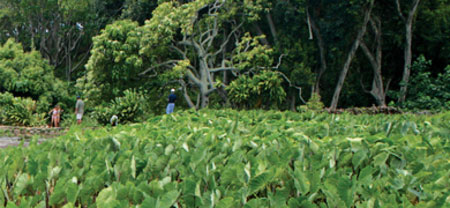Story by Sky Barnhart | Photography by Jason Moore | Dr. Grahame Jackson | Dr. Susan Miyasaka | Dr. Xiaoling He
 This story is the second in a series about kalo (taro) and its importance to the people of Hawai‘i.
This story is the second in a series about kalo (taro) and its importance to the people of Hawai‘i.
In the movie Jurassic Park, faced with the terrible specter of living dinosaurs recreated from prehistoric DNA, Dr. Ian Malcolm exclaims:
“The lack of humility before nature that’s being displayed here is staggering! . . . Your scientists were so preoccupied with whether or not they could, they didn’t stop to think if they should.”
One Maui resident used that quote when she testified before the Hawai‘i State Legislature in favor of a bill banning the genetic modification of kalo (taro). The words illustrate the deep concern shared by many kalo farmers and Native Hawaiians statewide about the ongoing push to manipulate the genes of a plant that is sacred to Native Hawaiians and to claim its ownership through patenting.
According to the Kumulipo, the Hawaiian creation chant, kalo is the elder brother of Haloa, the first Hawaiian, and thus, the elder brother of the Hawaiian race.
“Taro is family; how can you patent that?” demands Tweetie Lind. “You cannot. ‘Nuff already. Tell the scientists to leave us alone. We sure don’t see them planting food for the people. . . . No need tell us how to plant things over here.”
Tweetie and John Lind’s pride in their ancestry runs deep as the thick mud of the lo‘i kalo (taro patches) of their Kapahu Living Farm in rural Kïpahulu. The Linds grow kalo according to traditional methods: burying weeds and kukui leaves and stems as green manure, surrounding each lo‘i with a ditch to ensure a steady flow of fresh, cool water, and keeping their crops free of chemical fertilizers, herbicides or pesticides.





